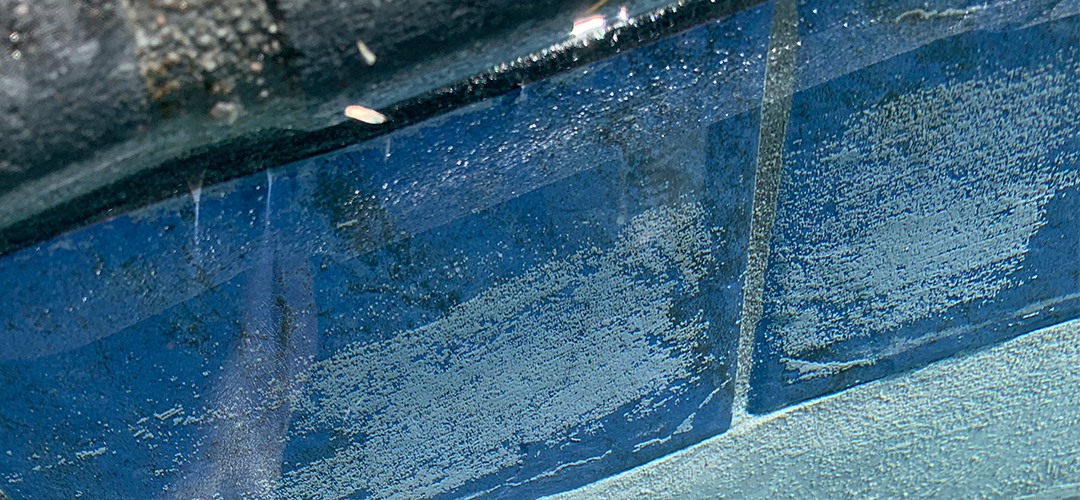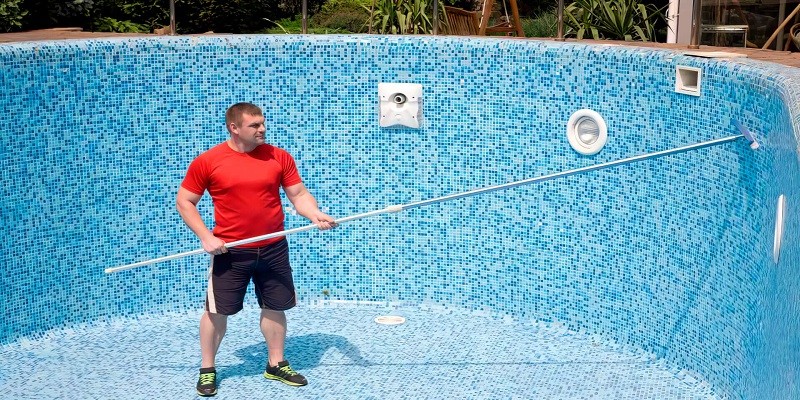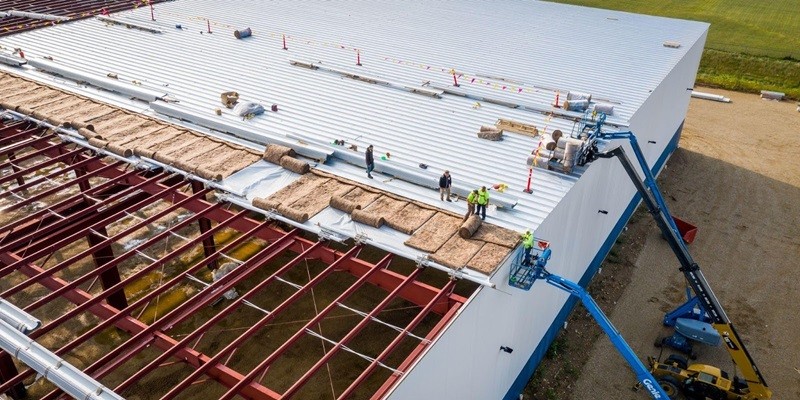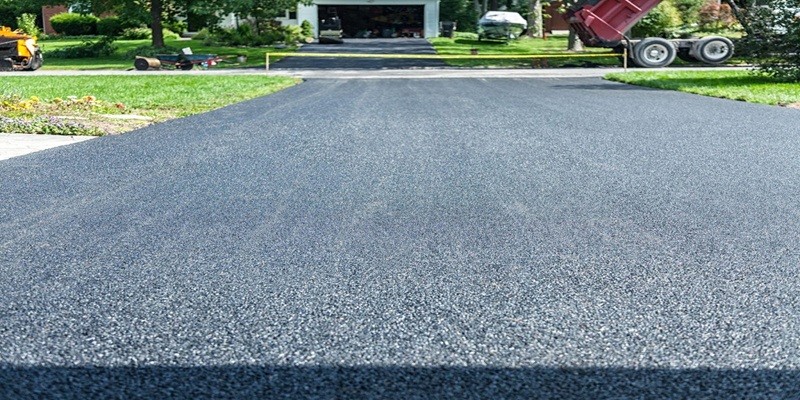Last Updated on September 13, 2023
To clean pool tile, use a mild acid solution and scrub gently with a non-abrasive brush. The buildup of stains, dirt, and grime on pool tiles can be effectively removed by following this simple and safe cleaning method.
Proper maintenance of pool tiles is essential to keep them looking clean and beautiful while preventing any damage from occurring. Regularly cleaning the tiles will help maintain their longevity and keep the pool looking pristine. We will provide a step-by-step guide on how to clean pool tile using the most effective and efficient methods.
So, let’s dive in and learn how to get those pool tiles sparkling again.
Factors To Consider When Selecting A Cleaning Solution
For effective pool tile cleaning, it is essential to consider factors such as the type of tile, the level of dirt and grime, and the potential harm to the tile surface. By carefully selecting a cleaning solution and following proper techniques, you can ensure a sparkling clean pool tile.
Pool tile cleaning is an essential task to maintain the beauty and hygiene of your swimming pool. Over time, pool tiles can accumulate dirt, grime, and stubborn stains that require thorough cleaning. When selecting a cleaning solution for pool tile, there are several factors to consider that can make the task more effective and environmentally friendly.
In this section, we will explore these factors in detail.
Compatibility With Pool Tile Materials
Different types of pool tiles, such as ceramic, glass, or natural stone, require specific cleaning solutions that won’t damage or degrade the material. Consider the following when choosing a cleaning solution:
- Ceramic tiles: These are durable and resistant to most acidic cleaning agents. A pH-neutral tile cleaner is suitable for ceramic tiles.
- Glass tiles: Gentler cleaning solutions should be used on glass tiles to prevent scratching or dulling the surface. Look for non-abrasive and non-acidic cleaners specifically formulated for glass.
- Natural stone tiles: Avoid acidic or abrasive cleaners as they can damage the stone’s surface. Opt for pH-neutral or stone-specific cleansers that won’t harm or discolor the tiles.
Effectiveness In Removing Stubborn Stains
Stubborn stains on pool tiles can be a challenging task to tackle. Find a cleaning solution that is effective in removing these stains without excessive scrubbing or harsh chemicals:
- Calcium deposits: Look for a cleaner that can dissolve calcium deposits effectively. This will help eliminate the white, chalky residue commonly found on pool tiles.
- Algae and mold stains: A cleaner with algae and mold-fighting properties will effectively remove these stubborn stains. Ensure that the solution is safe for both the pool tiles and the pool water.
- Oil and grease stains: Opt for a cleaner that can break down oils and grease without leaving behind any residue. This will help restore the shine and cleanliness of your pool tiles.
Environmental Friendliness
Choosing an environmentally friendly cleaning solution not only benefits the planet but also ensures the safety of your swimming pool and its users. Consider the following:
- Biodegradability: Look for pool tile cleaners that are biodegradable and environmentally responsible. This minimizes the impact on water sources and aquatic life.
- Non-toxic formulation: Avoid cleaners with harmful chemicals or toxic fumes. Opt for solutions that are gentle yet effective, keeping the pool environment safe for swimmers.
- Phosphate-free: Phosphates can contribute to algae growth in pools and harm the surrounding ecosystem. Select a cleaner that is phosphate-free to prevent these issues.
When selecting a cleaning solution for your pool tiles, always refer to the manufacturer’s recommendations and test the cleaner on a small, inconspicuous area before applying it to the entire pool tile surface. By considering the compatibility with pool tile materials, effectiveness in removing stubborn stains, and environmental friendliness of the cleaning solution, you can ensure a clean, beautiful, and eco-friendly swimming pool.
Popular Cleaning Solutions For Pool Tile
Discover effective cleaning solutions for pool tile to maintain a sparkling swimming pool. Learn how to clean pool tile effortlessly with these popular methods.
Pool tile can accumulate dirt, grime, and stains over time. To maintain its pristine appearance and keep your pool looking its best, regular cleaning is essential. Thankfully, there are several popular cleaning solutions for pool tile that can effectively tackle the task.
Here are some options to consider:
Vinegar And Water Mixture
- A combination of vinegar and water is an effective and eco-friendly solution for cleaning pool tile.
- Mix equal parts vinegar and water in a spray bottle.
- Spray the solution onto the tile and let it sit for a few minutes.
- Scrub the tile gently using a soft brush or sponge.
- Rinse the tile thoroughly with clean water.
Baking Soda Paste
- Baking soda is a versatile cleaning agent that can help remove stains and grime from pool tile.
- Create a paste by mixing baking soda with water until it forms a thick consistency.
- Apply the paste to the tile, focusing on areas with stubborn stains.
- Let the paste sit for a few minutes.
- Scrub the tile using a brush or sponge, applying gentle pressure.
- Rinse off the paste with clean water.
Commercial Pool Tile Cleaners
- There are various commercial pool tile cleaners available in the market that can effectively remove dirt and stains.
- Choose a cleaner specifically designed for pool tile.
- Follow the instructions provided on the product label for the best results.
- Typically, you will need to apply the cleaner to the tile, let it sit for a specified time, and then scrub and rinse the tile.
Enzyme-Based Cleaners
- Enzyme-based cleaners are a natural and safe option for cleaning pool tile.
- These cleaners contain enzymes that break down organic matter, such as algae and bacteria, on the tile surface.
- Apply the enzyme-based cleaner to the tile and let it sit for the recommended duration.
- Scrub the tile gently with a brush or sponge.
- Rinse off the cleaner with water.
Regular maintenance and cleaning of pool tile will help prolong its lifespan and keep it looking new. Choose the cleaning solution that works best for you and enjoy a clean and sparkling pool.
Proper Application And Safety Precautions
Ensure proper application and safety precautions when cleaning pool tile to maintain a clean and safe swimming environment. Following these guidelines will help you effectively clean your pool tile without any risk or damage.
To effectively clean pool tile, it is important to follow proper application techniques and prioritize safety precautions. Here are some guidelines to ensure a successful cleaning process:
Diluting The Cleaning Solution:
- Mix the cleaning solution according to the manufacturer’s instructions.
- Typically, you will need to dilute the solution with water to the recommended ratio.
- Consistently follow the specified ratio to achieve the desired results.
Using A Soft Brush Or Non-Abrasive Sponge:
- Prior to applying the cleaning solution, gather a soft brush or non-abrasive sponge.
- Gently scrub the pool tile surface to remove dirt, grime, or algae buildup.
- Ensure that you target all areas of the tile for a thorough clean.
- Avoid using harsh scrub brushes or abrasive sponges that can damage the tile surface.
Wearing Protective Gloves And Eyewear:
- Before starting the cleaning process, prioritize your safety by wearing protective gloves and eyewear.
- Cleaning solutions may contain chemicals that can irritate your skin and eyes.
- By wearing gloves and eyewear, you minimize the risk of direct contact with the cleaning solution.
- Remember to handle the cleaning solution with care to avoid any accidents or harm.
Remember, consistently following these proper application techniques and safety precautions will help you effectively clean your pool tile while prioritizing your well-being.
Now that we have covered the proper application techniques and safety precautions, let’s move on to the next section: “Additional Tips for Maintaining Pool Tile. “
Scrubbing And Brushing The Tiles
Scrubbing and brushing tiles is an essential step in cleaning pool tile. This process helps to remove dirt, grime, and algae from the surface, leaving your tiles looking sparkling and fresh.
Keeping pool tiles clean is an essential part of pool maintenance. Over time, tiles can become dirty, stained, or covered in unsightly calcium and mineral deposits. Thankfully, there are effective methods for cleaning pool tiles. In this section, we will explore two popular techniques: manual scrubbing with a soft brush and using a pool tile brush attachment for a pool cleaner.
Manual Scrubbing With A Soft Brush
- Start by filling a bucket with warm water.
- Dip a soft-bristle brush, such as a nylon or plastic brush, into the bucket.
- Gently scrub the tiles in a circular motion, focusing on the areas with visible dirt or grime.
- Rinse the brush frequently in the bucket to remove any accumulated debris.
- Apply gentle pressure to avoid damaging the tile surface.
- For tougher stains, you can create a cleaning solution by mixing equal parts water and vinegar or water and baking soda. Apply the solution to the affected areas and scrub with the soft brush.
- Once you’ve scrubbed all the tiles, rinse them thoroughly with clean water.
Using A Pool Tile Brush Attachment For A Pool Cleaner
- If you have access to a pool cleaner with a pool tile brush attachment, it can be a time-saving option for cleaning pool tiles.
- Attach the pool tile brush to the pool cleaner as per the manufacturer’s instructions.
- Lower the pool cleaner into the water, ensuring the brush attachment is in contact with the tiles.
- Turn on the pool cleaner and allow it to move along the tile surface, gently scrubbing away dirt and debris.
- Make sure to move the pool cleaner slowly and methodically, covering all the tiles.
- If the pool cleaner has adjustable pressure settings, opt for a lower setting to avoid damaging the tiles.
- Once the pool cleaner has finished its cycle, inspect the tiles to ensure they are clean. If any stubborn stains remain, you may need to manually scrub those areas with a soft brush.
Remember, whether you choose to manually scrub the tiles or use a pool cleaner with a brush attachment, it’s essential to use gentle pressure to preserve the integrity of the tiles. Regular cleaning and maintenance will not only keep your pool tiles looking pristine but also help extend their lifespan.
So, make it a part of your pool care routine and enjoy sparkling clean tiles year-round.
Pressure Washing The Pool Tiles
Looking for a hassle-free way to clean your pool tiles? Discover the secret to sparkling pool tiles with our effective pressure washing technique. Say goodbye to grime and hello to a pristine pool in no time!
Renting Or Purchasing A Pressure Washer:
- Renting a pressure washer: Renting a pressure washer is a cost-effective option, especially if you don’t plan on using it frequently. Look for local hardware stores or equipment rental companies that offer pressure washers for rent. Make sure to choose a pressure washer suitable for cleaning pool tiles.
- Purchasing a pressure washer: If you have a pool or plan on cleaning pool tiles regularly, investing in a pressure washer might be a smart choice. Consider the pressure washer’s water pressure and flow rate when making your purchase. Opt for a model that is designed specifically for pool tile cleaning.
Adjusting The Pressure Settings For Different Types Of Tile:
- Ceramic or porcelain tiles: These tiles are quite durable and can withstand higher water pressure. Adjust the pressure washer to a medium setting for effective cleaning without causing any damage.
- Natural stone tiles: Natural stone tiles such as travertine or slate are more delicate and require a lower pressure setting. Set the pressure washer to a gentle or low setting to prevent any chipping or scratching.
- Glass or mosaic tiles: These tiles are prone to cracking if subjected to high water pressure. Use a low-pressure setting, or opt for a spray attachment with a wider spray pattern to distribute the pressure evenly.
Ensuring Proper Distance And Angle During Pressure Washing:
- Maintain a suitable distance: Stand 1 to 2 feet away from the pool tiles to ensure effective cleaning without causing any damage. Adjust the distance based on the pressure washer’s power and the condition of the tiles.
- Angle the nozzle correctly: Hold the pressure washer nozzle at a 45-degree angle to the tiles. This angle allows the water to hit the tiles at an optimal angle, removing debris and grime effectively.
- Work in small sections: Divide the pool tile into manageable sections and focus on one area at a time. This method ensures thorough cleaning and prevents the water from drying out before you can scrub away the dirt.
Remember, using a pressure washer requires caution and precision. Pay attention to the pressure settings, distance, and angle to clean your pool tiles effectively and safely. Regular maintenance and cleaning will help keep your pool looking pristine and inviting for a refreshing swim.
Steam Cleaning The Pool Tiles
Learn how to clean pool tile effectively with steam cleaning. This method removes dirt, grime, and calcium deposits, leaving your pool tiles sparkling clean and looking brand new.
Renting Or Purchasing A Steam Cleaner
Renting a steam cleaner is a cost-effective option if you only plan to clean your pool tiles occasionally. Here’s what you need to know:
- Visit your local hardware store or home improvement center to inquire about rental options.
- Choose a steam cleaner specifically designed for hard surfaces like pool tiles.
- Ensure the steam cleaner comes with appropriate attachments for effective tile cleaning.
- Check the rental terms, including the cost, duration, and any additional fees or deposits required.
If you have a pool with regular tile cleaning requirements, investing in a steam cleaner might be a better choice. Consider the benefits:
- Owning a steam cleaner provides convenience and saves money in the long run.
- You can clean your pool tiles whenever necessary, without relying on rental availability.
- Look for a steam cleaner that offers features like adjustable steam pressure and different nozzle attachments for versatile cleaning.
Preparing The Steam Cleaner For Use
Before you begin cleaning your pool tiles with a steam cleaner, follow these important steps:
- Familiarize yourself with the manufacturer’s instructions for your specific steam cleaner model.
- Fill the steam cleaner with distilled water instead of tap water to prevent mineral buildup.
- Allow the steam cleaner to heat up and produce steam as directed by the manufacturer.
- Attach the appropriate nozzle or brush attachment suitable for cleaning pool tiles.
Additional tips to prepare your steam cleaner effectively:
- Check the condition of the cord and plug. Replace or repair any damaged components.
- Ensure the water tank is securely in place to prevent leaks during use.
- Position the steam cleaner near an electrical outlet that is compatible with the machine’s power requirements.
Slowly Moving The Steam Cleaner Across The Tile Surface
When it’s time to clean your pool tiles with a steam cleaner, follow these techniques for optimal results:
- Start by turning on the steam cleaner and allowing it to produce a steady flow of steam.
- Hold the steam cleaner nozzle close to the pool tiles without touching them to avoid damage.
- Slowly move the steam cleaner in straight lines or circular motions, depending on your preference.
- Ensure that every section of the tile surface receives enough steam and attention.
- Pay extra attention to areas with heavier grime or mineral deposits, focusing the steam on those spots for a longer duration.
Additional pointers for a thorough cleaning experience:
- Take breaks if necessary, as steam cleaning large pool tile surfaces can be physically demanding.
- Have a clean microfiber cloth or mop ready to wipe away the loosened dirt and grime while steam cleaning.
- Regularly check the steam cleaner’s water level and refill if needed to maintain uninterrupted cleaning.
- After cleaning, allow the tiles to dry completely before using the pool to prevent slipping accidents.
Now that you are equipped with the knowledge of renting or purchasing a steam cleaner, as well as preparing and using it, you can confidently keep your pool tiles sparkling clean. Remember to maintain regular cleaning routines to prevent stubborn buildup and preserve the beauty of your pool area.
Regular Cleaning And Maintenance Schedule
Learn how to keep your pool tile sparkling clean with a regular cleaning and maintenance schedule. Follow our step-by-step guide to remove dirt, grime, and mineral deposits from your pool tile and maintain its pristine condition.
Keeping your pool tile clean and well-maintained is essential for its longevity and overall appearance. By setting a regular cleaning routine, you can easily stay on top of any buildup or grime, ensuring your pool tile remains sparkling and inviting.
Here’s a step-by-step guide on how to establish a cleaning schedule that will keep your pool tile in tip-top shape:
Setting A Cleaning Routine
- At the start of each pool season, designate a specific day each week for pool tile cleaning. This will help you stay consistent and maintain a clean pool all season long.
- Begin by inspecting the pool tile for any visible stains, calcium deposits, or mold growth.
- Gather the necessary cleaning supplies, such as a pool tile cleaner, a soft-bristle brush, a bucket, and safety goggles.
- Put on your safety goggles to protect your eyes from any splashes or cleaning chemicals.
- Dilute the pool tile cleaner according to the instructions on the packaging. Always follow safety precautions and guidelines provided by the manufacturer.
- Starting from one end of the pool, dip the brush into the cleaning solution and scrub the tile gently in a circular motion. Be sure to focus on any areas with visible stains or buildup.
- As you clean, periodically rinse the brush in the bucket to remove any debris or excess cleaning solution.
- Once you’ve cleaned the entire pool tile surface, rinse thoroughly with clean water. This will remove any residue from the cleaning solution and ensure a spotless finish.
- After rinsing, inspect the tile to ensure all stains and buildup have been successfully removed. If necessary, repeat the cleaning process in stubborn areas.
- Finally, dry the pool tile surface using a soft, clean cloth or allow it to air-dry naturally.
Quick Cleaning After Pool Use
- In addition to your regular cleaning routine, it’s essential to perform quick cleaning after each pool use to prevent any dirt or debris from settling and causing stains or damage.
- Keep a pool maintenance kit handy near your pool area, which should include a skimmer net and a pool brush.
- Use the skimmer net to remove any leaves, insects, or other debris floating on the water’s surface.
- Inspect the pool tile for any visible dirt or grime. If you notice any, use the pool brush to give it a quick scrub.
- Pay extra attention to the waterline area, as it tends to accumulate more dirt and oils from swimmers.
- After removing any debris and giving the tile a quick scrub, ensure the pool water is properly balanced by testing and adjusting the chemical levels if necessary.
- Lastly, run the pool filter system for at least one hour to circulate and filter the water, keeping it clean and clear.
By following this regular cleaning and maintenance schedule, you can enjoy a clean and inviting pool tile all season long. Making these tasks a habit will not only keep your pool tile looking its best but also minimize the chances of any long-term damage or expensive repairs.
So, dive in and make pool tile cleaning a regular part of your pool maintenance routine.

Credit: www.swimmingpool.com
Using Pool Tile Sealants
Pool tile sealants are essential for maintaining clean and sparkling pool tiles. By using the right products and following the proper cleaning techniques, you can easily remove dirt, algae, and other debris from your pool tiles, keeping your pool looking beautiful all year round.
Applying A Tile Sealant After Cleaning
Pool tile sealants are an essential part of maintaining the beauty and longevity of your pool tiles. After you have thoroughly cleaned your pool tiles, applying a tile sealant will help protect them from the damaging effects of water, chemicals, and the elements.
Here is a step-by-step guide on how to apply a tile sealant to your pool tiles:
Prepare the tiles:
- Ensure that the tiles are clean, dry, and free of any debris or residue.
- Use a mild, non-abrasive cleaner to remove any dirt or stains if necessary.
- Rinse the tiles thoroughly with clean water and let them dry completely.
Choose the right sealant:
- There are various types of pool tile sealants available, such as silicone-based, epoxy-based, or acrylic-based sealants.
- Consider the type of tiles you have and their specific needs when selecting a sealant.
- Read the manufacturer’s instructions to ensure that the sealant is suitable for your pool tiles.
Apply the sealant:
- Wear protective gloves and goggles before applying the sealant to protect your skin and eyes.
- Use a brush or roller specifically designed for applying sealants to evenly coat the tiles.
- Start from the top of the tiles and work your way down, ensuring complete coverage.
- Apply the sealant in thin, even coats, avoiding excessive build-up or drips.
- Allow the first coat to dry completely before applying additional coats if necessary.
Maintain the sealant:
- Regularly inspect the sealed tiles for any signs of wear or damage.
- Touch up any areas that may require additional sealing to prevent any potential water or chemical penetration.
- Follow the manufacturer’s recommendations for resealing intervals to maintain optimal protection.
Using a pool tile sealant is a critical step in the maintenance routine of your pool tiles. By following these steps and selecting an appropriate sealant, you can ensure the long-lasting beauty and durability of your pool tiles. Remember to always follow the manufacturer’s instructions and take the necessary precautions during the application process.
Proper Water Chemistry And Ph Balance
Maintaining proper water chemistry and pH balance is essential for cleaning pool tile effectively. By ensuring the right chemical levels, you can prevent buildup and stains, keeping your pool tile looking pristine.
Maintaining proper water chemistry and pH balance is crucial for keeping your pool tiles clean and preventing the buildup of mineral deposits. Here are some essential steps to monitor and maintain the water chemistry in your pool:
- Test the water regularly using a pool water testing kit to ensure the chemical balance is optimal.
- Keep the pH levels between 7.2 and 7.8 to prevent the growth of algae and scale formation.
- Adjust the pH levels using pH increasers or decreasers as necessary, following the manufacturer’s instructions.
- Keep an eye on the total alkalinity levels and maintain them between 80 and 120 parts per million (ppm).
- Use a pool water stabilizer to prevent rapid chlorine loss due to sunlight exposure.
- Monitor the chlorine levels and keep them within the recommended range of 1 to 3 ppm to sanitize the pool water effectively.
- Use a pool shock treatment regularly to remove organic contaminants and maintain crystal clear water.
Avoiding High Calcium And Mineral Levels
High levels of calcium and other minerals can cause scaling and stubborn deposits on your pool tiles. Here’s how you can prevent this issue:
- Monitor the calcium hardness levels and keep them within the range of 200 to 400 ppm.
- If the calcium levels are high, you can partially drain and refill the pool with fresh water to dilute the concentration.
- Avoid using hard water for your pool, especially if your area has a high mineral content.
- Regularly brush the pool walls and tiles to prevent the accumulation of mineral deposits.
- Consider using a sequestering agent to prevent minerals from precipitating out of the water and causing scaling.
- Install a water softening system if your pool consistently has high mineral levels.
By following these guidelines and regularly monitoring and maintaining the water chemistry and pH balance of your pool, you can effectively clean and prevent the buildup of mineral deposits on your pool tiles. Remember to consult with a professional or refer to the manufacturer’s instructions for specific product recommendations and usage.
Frequently Asked Questions Of How To Clean Pool Tile?
What Is The Best Way To Clean Tile In A Pool?
The best way to clean tile in a pool is by using a pool tile cleaner and scrubbing gently to remove dirt and stains.
What Is Safe To Clean Pool Tile With?
You can safely clean pool tile with a mild acid-based cleaner or a non-abrasive tile cleaner.
How Do I Make My Pool Tiles Look New?
To make your pool tiles look new, clean them regularly using a pool tile cleaner and a soft brush.
How Do You Remove Buildup From Pool Tiles?
To remove buildup from pool tiles, use a pool tile cleaner and gently scrub the tiles.
Conclusion
Maintaining a clean pool tile is essential for a visually appealing and hygienic swimming experience. By following the steps outlined in this blog post, you can keep your pool tile looking fresh and sparkling. Regularly brushing the tiles and using a mild cleaning solution can prevent the build-up of dirt, algae, and mineral deposits.
Remember to use a soft-bristle brush to avoid damaging the tile surface. In addition, conducting regular water chemistry tests and balancing the pool water can minimize the formation of stains. For tougher stains and deposits, using specialized tile cleaners and scrubbing gently can restore the tile’s original shine.
Lastly, preventive measures such as regular pool maintenance, skimming, and using a pool cover can significantly reduce the amount of debris that comes into contact with the tile. By implementing these cleaning and maintenance practices, you can ensure a beautiful and inviting pool environment for years to come.










